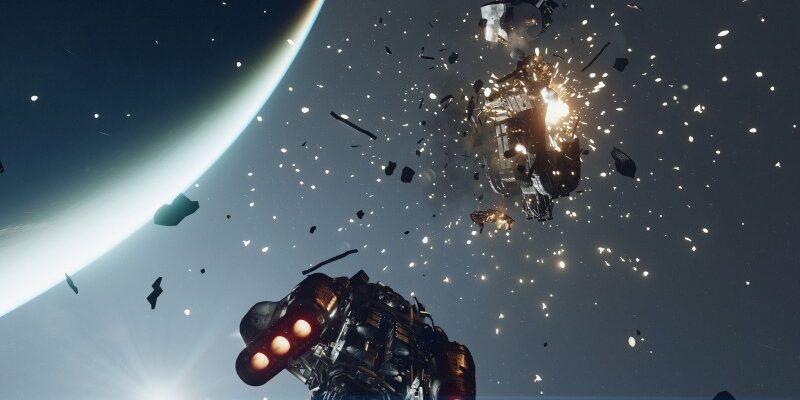Even in the increasingly crowded marketplace of big, expansive games, Starfield stands out. Leveraging the gameplay Bethesda popularized with The Elder Scrolls and Fallout games, Starfield expands the breadth of exploration to a galaxy of solar systems, planets, and ships. It populates those environments with a rich palette of activities and missions that tap into the outer space fantasy. It’s a staggering span of content to wrap one’s head around. At times, that scope threatens to impair the focus and pacing, and moment-to-moment gameplay is not always a strong suit. But players can expect to uncover hundreds of hours of experimentation in a richly imagined sci-fi playground, and that thrill is worth experiencing.
Your crafted character begins life as a space miner who inexplicably connects with an inscrutable buried artifact, granting visions of a grand cosmic mystery. That foundational event puts you in contact with a tightly-knit group of explorers working to decipher the secret. The introduction opens the door to your adventures across a vast network of human colony worlds that has sprung up after an exodus from Earth.
Character dialogue and storytelling is top-notch, with novel personalities and interactions every step of the way. The mostly independent storylines of different factions, corporations, and companions each tap into different sci-fi tropes, from being hunted by a monstrous xenoweapon alien to infiltrating a pirate fleet to being a frontier lawman on the fringes of known space. The variety of these experiences keeps things fresh, especially when you layer in additional emergent opportunities, like setting up mining outposts, surveying planets, buying and decorating a home, or pursuing a romance with one of your companions.
Starfield is a game of endless distractions, where new mission threads and activities are constantly beckoning. I found the most enjoyment when I allowed those threads to pull me to and fro, creating a web of interactions I could flip between as I saw fit. Some activities, like visiting alien temples, hunting down merc ships, or clearing out bases of outlaws, can start to feel repetitive if taken on without a break to do other things. I also grew frustrated at the frequent ping-ponging between mission givers and destinations; even with fast travel, it felt especially egregious to be flying to an entirely different star system only to fly back to tell someone what I saw there. Nonetheless, several mission moments are standout and memorable, like a research lab shifting between different states of reality or a corporate espionage exchange in the back room of a dance club. In its best moments, I was immersed in Starfield’s unfolding tale.
The joy of exploration is a core tenet of play, and nailing that sensation is central to Starfield’s success. I loved landing on a new planet and seeing unknown megafauna wandering the plains or entering a new city and finding the seediest dive bar. Arrive in a new system and dock with a derelict space station – who knows what’s inside? Starfield is a story about both the good and the bad of humanity’s desire to reach further and uncover what’s just out of grasp, and I love that those themes weave into the flow of how players may approach the game. That engagement is only enhanced by the high quality of the presentation; this is an immaculate visual landscape filled with details juxtaposed against the grandeur of space, accentuated by a wistful, questing musical score that always nails the right mood.
I found navigating Starfield obtuse, both in moving around a giant map of stars and its U.I. and systems. Figuring out how to do basic tasks, like selling excess inventory, modifying my ship, adjusting crew assignments, or reaching a particular star system, often made me scratch my head. The constant need to enter menus to reach destinations hampers the sensation of seamless travel. I started to feel like it was a car dashboard where no button was where I expected it to be. But once I learned my way around, it was a vehicle that took me to some remarkable destinations.
Ground combat is central to the experience, and most players are likely to spend a significant chunk of time with a gun in their hand, even if they try as I did, to lean into persuasion and stealth for many encounters. I enjoyed the diversity of weapons, from laser rifles to shotguns that seemed yanked out of an old Western. Traversal is thrilling thanks to the jet boost packs you can wear on your back to leap and mantle through environments quickly. But gunplay feels stiff and mechanical, and enemies pursue unwise pathing and positioning that rarely leads to real challenge or tension. Pulling out the big guns and laying waste to a base of baddies is entertaining, but the action itself left me cold.
Shipborne space combat also plays a big role, and I love having a chance to tap into that craving. But I rarely encountered battles that clicked. I completely wiped out the enemy forces in moments, or the ships arrayed against me were way out of my league – there was little in between.
It took me a long time to fall in love with Starfield, and even after I did, certain aspects didn’t work for me. But the things I didn’t enjoy are vastly outweighed by my enthusiasm for this new, original science fiction universe, the breadth of its adventures, and the appeal of its many interwoven stories. Go in with the expectation that it will take some time to find your footing in such a vast gameplay space, and there’s a universe well worth discovering here.
Products In This Article
Starfield
Source: Read Full Article






